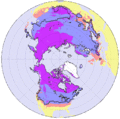Polar regions of Earth: Difference between revisions
A.amitkumar (talk | contribs) m Reverted edits by 72.237.91.229 (talk) to last revision by ClueBot NG (HG) |
Tag: possible vandalism |
||
| Line 59: | Line 59: | ||
** [[List of antarctic and sub-antarctic islands|Antarctic & Sub-Antarctic Islands]] |
** [[List of antarctic and sub-antarctic islands|Antarctic & Sub-Antarctic Islands]] |
||
cookies |
|||
=== Arctic === |
|||
icecream |
|||
* [[Arctic]] |
|||
* [[Arctic exploration]] |
|||
* [[Arctic Circle]] |
|||
* [[Arctic Ocean]] |
|||
* [[Canadian Arctic Archipelago]] |
|||
* [[Arctic cooperation and politics]] |
|||
=== Polar === |
=== Polar === |
||
Revision as of 16:50, 2 October 2013
Earth's polar regions are the areas of the globe surrounding the poles also known as frigid zones. The North Pole and South Pole being the centres, these regions are dominated by the polar ice caps, resting respectively on the Arctic Ocean and the continent of Antarctica.
-
The frigid zones.
-
Location of the polar regions.
-
Northern Hemisphere permafrost (permanently frozen ground) in purple.
Definitions
The Arctic has numerous definitions, including the region north of the Arctic Circle currently (Epoch 2010 at 66°33'44" N), or the region north of 60° north latitude, or the region from the North Pole south to the timberline.
The Antarctic is usually defined as south of 60° south latitude, or the continent of Antarctica. The 1959 Antarctic Treaty uses the former definition.
The two polar regions are distinguished from the other two climatic and biomatic belts of Earth, a tropics belt near the equator, and two middle latitude regions located between the tropics and polar regions.
Climate
Polar region receive less intensive solar radiation because the sun's energy arrives at an oblique angle, spreading over a larger area, and also travels a longer distance through the Earth's atmosphere in which it may be absorbed, scattered or reflected, which is the same thing that causes winters to be colder than the rest of the year in temperate areas.
The axial tilt of the Earth has a major effect on climate of the polar regions. Since the polar regions are the farthest from the equator, they receive the least amount of sunlight and are therefore frigid. The large amount of ice and snow also reflects a large part of what little sunlight the Polar regions receive, contributing to the cold. Polar regions are characterized by the polar climate, extremely cold temperatures, heavy glaciation wherever there is sufficient precipitation to form permanent ice, and extreme variations in daylight hours, with twenty-four hours of daylight in summer, and complete darkness at mid-winter.
Circumpolar Arctic Region
There are many settlements in Earth's north polar region. Countries with claims to Arctic regions are: the United States (Alaska), Canada, Denmark (Greenland), Norway, Finland, Sweden and Russia. Arctic circumpolar populations often share more in common with each other than with other populations within their national boundaries. As such, the northern polar region is diverse in human settlements and cultures.
Antarctica and the Southern Ocean
The southern polar region has no permanent human habitation. McMurdo Station is the largest research station in Antarctica, run by the United States. Other notable stations include Palmer Station and Amundsen-Scott South Pole Station (United States), Esperanza Base and Marambio Base (Argentina), Scott Base (New Zealand), and Vostok Station (Russia).
While there are no indigenous human cultures, there is a complex ecosystem, especially along Antarctica's coastal zones. Coastal upwelling provides abundant nutrients which feeds krill, a type of marine crustacea, which in turn feeds a complex of living creatures from penguins to blue whales.
Extraterrestrial polar regions
Other planets and natural satellites in the solar system have interesting quirks about their polar regions. Earth's Moon is thought to contain substantial deposits of ice in deep craters in its polar regions, which never see direct sunlight. Mars, like Earth, has polar ice caps. On Uranus, meanwhile, the extreme tilt of the planet's axis leads to the poles alternately pointing almost directly at the Sun.
Gallery
-
North polar region
-
Antarctic mountain
-
North polar region polar bears
-
South polar region penguin
-
Polar scenes
-
Polar ice stream
-
South pole at image bottom
-
Purple aurora
-
Polar Bear
See also
Antarctic
- Antarctica
- Ecozone of Antarctica
- Expeditions of Antarctica
- Geography of Antarctica
- History of Antarctica
cookies icecream
Polar
External links
- Template:Dmoz
- The Polar Regions
- International Polar Foundation
- Arctic Environmental Atlas (UNDP)
- Earth's Polar Regions on Windows to the Universe
- Arctic Studies Center, Smithsonian Institution
- Scott Polar Research Institute, University of Cambridge
- WWF:The Polar Regions
- World Environment Day 2007 "Melting Ice" image gallery at The Guardian
- Polar Discovery
References
- Victor, Paul-Émile. Man and the Conquest of the Poles, trans. by Scott Sullivan. New York: Simon & Schuster, 1963.












